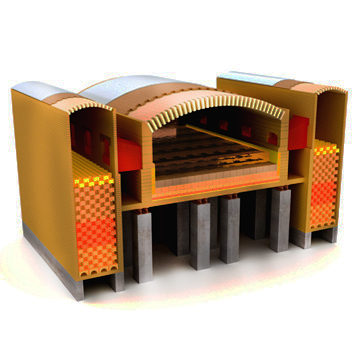
Product List
Success Case
Contact Us
- 0086 371 63838939
- 0086 371 63835539
- sales@sunriserefr.com
- tkfanyi
- No.36 Fengchan Road, Zhengzhou City

News
How To Select Refractories For Glass Furnaces
- More related products
- Fused Cast AZS
- Fused Cast Alumina Block
- Fused Cast High Zirconia Block
- Fused Cast Skid Rail Block
Refractory materials are the main construction materials of glass furnaces. It has a decisive impact on glass quality and energy consumption as well as production costs. The development of glass melting technology heavily replies on the development of the manufacturing technology of refractory materials and the improvement of the quality of refractory materials.

For most large float glass lines, glass furnaces generally consist of L-shaped hanging wall(silica brick), the melting zone(fused cast refractories used in parts in direct contact with glass liquid, silica brick or fused cast refractories in the superstructure), throat(silica brick), cooling zone(corundum brick in parts in direct contact with glass liquid, silica brick or corundum brick in other parts), annealing zone and regenerators(fireclay brick, high alumina brick, directly bonded magnesia chrome brick).
1. Crown
The crown of the melting zone and cooling zone usually works under 1600℃, so refractory materials in these parts are subjected to high temperature, load, alkali gases and impact of batch materials. therefore, refractory materials used in the crown should have high refractoriness, high softening temperature under load, good creep resistance, low thermal conductivity, no pollution to glass liquid, low bulk density and high strength.
And high-quality high-purity silica brick just have the above characteristics:
(1) High softening temperature under load, close to its refractoriness;
(2) Good thermal stability under high temperature and high strength;
(3) Since its SiO2 content is more than 96%, which is same to that of glass, it does not pollute glass liquid;
(4) Low price.
Therefore, it is preferred by many glass manufacturers.
The main reasons for the corrosion of the crown are the chemical reaction between the fly ash and alkali vapor and refractory materials and the crystalline transformation and changes on the organizational structure compactness caused by temperature and phase migration. Studies have shown that the corrosion course of high quality silica bricks used in the crown is the course of phase transition and migration of impurities, while the chemical corrosion and the melting effect is extremely slight. Phase transition and self-purification results in the change of working zone and improvement of high temperature properties.
2. Sidewall
(1) Parts in contact with glass
The parts of sidewall of the melting zone and cooling zone in direct contact with glass are subjected to chemical corrosion by high temperature glass liquid and mechanical wear by glass flow. Refractory materials in this part are required to have excellent corrosion resistance to glass liquid and no pollution to glass. Fused cast AZS block and α-β fused cast alumina block are qualified. The high temperature properties and corrosion resistance to glass make it suitable to the sidewall of the melting zone. The main crystalline phase ofα-β andβ fused cast alumina block is corundum. They contain a slight amount of glass phase, almost 1-2%. They have good corrosion resistance. Compared to fused cast AZS, since it contains no ZrO2 crystals, its reaction layer has low viscosity, so it is unstable at high temperatures. But when used under 1350℃, its corrosion resistance of α-β andβ fused cast alumina block is better than that of fused cast AZS. Therefore, they are the ideal refractory materials for the cooling zone.
(2) Parts not in contact with glass
The parts of sidewall of the melting zone and cooling zone not in contact with glass are also called breast walls. These parts are mainly affected by the alkali vapor and wear of batch materials. Depending on the design, sometimes corundum materilas are used, while sometimes silica brick is used. Both the two kinds of materials can meet the requirements. For silica bricks, both hanging bricks and straight bricks are used in this part.
3. Regenerators
(1) Arch and sidewall
The inner face of the arch and sidewall is subjected to high temperature, dust and alkali vapor. From top to down, the corrosion is gradually weakened. The selection of refractory materials is based on the temperature and corrosion conditions. Silica brick and high quality silica brick are used in the arch and sidewall. High alumina brick and low porosity fire clay brick are used in the middle part of the sidewall; low porosity fire clay brick and common fire clay brick are used in the lower part of the sidewall. According to the design, recently directly bonded magnesia chrome brick, common magnesia chrome brick and magnesia alumina brick are used in the middle and lower part of the sidewall and have achieved good results.
(2) Checker bricks
Since checker bricks are subjected to high temperature, ash and dust and alkali vapor, they suffer more serious corrosion than arch and sidewalls and, thus, have higher requirements for refractory materials. the clogging and collapsing of checker bricks is the main reasons for the cold repair of glass furnaces. Therefore, checker bricks should have higher mechanical strength, low creep rate, good resistance to changes in temperature and atmosphere and alkali corrosion, no adhesion of dust and slow damage rate.
In the top part, fused rebonded magnesia brick is used; in the upper part, 95 magnesia brick is used; in the middle part, direct bonded magnesia chrome brick, magnesia spinel brick and magnesia olivine brick are used; in the lower part, low porosity fire clay brick is used.
- Read more
- The Application Of Fused Cast AZS Block In The Sidewall Of Glass Furnaces
- Refractory Selection for Oxy-Fuel Glass Furnaces
- How To Prolong The Service Life Of Glass Furnace
- Forehearth Types And Refractory Selection for The Glass Furnace
- Refractory Selection And Repair Of The Glass Furnace Bottom
Leave Message
For more information on any of our products please get in touch using the form below. One of our sales team will respond to your enquiry as soon as possible.

Copyright © 2014 Zhengzhou Sunrise Refractory Co., Ltd. 豫ICP备13002126号












